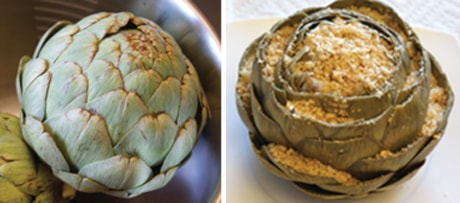The artichoke is among the most visually fascinating vegetables. We have all seen this odd vegetables while cruising the produce aisle of the grocery store.
Its conspicuous army green colour and grenade-like appearance has lured many eyes. Some have even given into their curiosity and reached over and tried fondling it only to quickly put it back because of its prickly thorns.
But don’t judge this veggie by its thorny thistle. Once you get past the look, the pain, and the labour of preparing this green, they are well worth it.
The artichoke is the immature flower head or unopened bud of the prickly but elegant-looking artichoke plant. The bud contains the heart, the meaty core of the artichoke, and is topped by a fuzzy center, or choke. Rows of petals surround the artichoke heart.
During preparation for cooking, the center choke (except in baby artichokes) must be discarded, but the base of the petals, the center of the stem and the entire artichoke heart is edible .
When choosing an artichoke, look for deep-green, tight-leafed globes that feel heavy for their size. If you hear a squeak when you squeeze the artichoke’s leaves together, it’s a fresh one. Discoloration, bruising or split leaves are signs of age, though, in summer and fall, you may find fresh artichokes with purple-tinged leaves.
Artichokes can be steamed, boiled, baked, fried, and stuffed. Cooked, they are delicious served hot or cold. Depending on their size, small, medium and large, artichokes can work as an appetizer, side dish or, in the case of the jumbo variety, a main entrée.
Baking, boiling and steaming are the most popular cooking methods for the basic stand-alone artichoke.
To prepare an artichoke, you first rinse it in cold water to remove any dwellers that have taken residence in the thistle. Cut off the top inch or so from each artichoke. If there are any leaves with thorns on their tops remaining, pull them out. Covered, and particularly cut artichokes can turn brown due to the acids and chlorophyll oxidation. If not cooked immediately, placing them in water lightly acidulated with vinegar or lemon juice prevents the discoloration.
Cooking time depends on artichoke size. Check for doneness by pulling out an inner leaf, making sure it comes out easily. Boil artichokes in salted water 20 to 45 minutes, until artichokes are tender. Steamed artichokes take about for 15 to 30 minutes. For extra flavour, you can add a vegetable bouillon cube, lemon juice or vinegar to the artichoke boiling or steaming water . Drain artichokes well, upside down.
With barbecue season well under way, consider adding artichoke halves onto the grill. The slightly smoky taste compliments the nuttiness of the artichoke.
Another method for cooking artichokes that add a bit more elegance to the vegetable is to stuff them and then bake them. All sorts of stuffing including combination like breadcrumbs with sausage and garlic shrimp will complement the green vegetable.
Actually eating the artichoke is a hands-on affair. Leaves are often removed and eaten one at a time, sometimes dipped in hollandaise, vinegar, butter, mayonnaise, lemon juice or other sauces. The remaining heart is then eaten, after removal of the inedible “choke”.
So on your next journey through the produce isle, consider adding this hearty vegetable to your shopping cart.
Artichokes Stuffed With
Lemon-Garlic Breadcrumbs
2 cups (500ml) fresh breadcrumbs from crustless French bread
50ml (1/4 cup) olive oil
2 tablespoons (30ml ) fresh lemon juice
1 tablespoon(15ml) chopped fresh oregano
3 garlic cloves, minced
1 teaspoon (95ml) grated lemon peel
6 medium artichokes, trimmed, left whole, chokes removed
2 tablespoons (30ml) butter, cut into 6 pieces
1/2 cup (or more) water
Lemon wedges
Preheat oven to 400°F. Mix breadcrumbs and oil in medium bowl. Spread mixture on large rimmed baking sheet. Bake until golden on edges, stirring occasionally, about 10 minutes. Transfer to large bowl. Mix in lemon juice, oregano, garlic and lemon peel. Season with salt and pepper.
Drain artichokes. Gently pull leaves outward from center until leaves open slightly. Fill artichoke cavities with bread stuffing. Pack stuffing between leaves. Place artichokes in 13 x 9 x 2-inch glass baking dish. Dot tops with butter. Pour 1/2 cup water into dish.
Cover dish with foil; bake until wooden skewer pierces artichokes easily, adding more water as necessary, about 40 minutes. Remove foil. Continue baking until tops are golden, about 20 minutes.
Serve with lemon wedges.
Grilled Artichoke
4 large artichokes
¼ cup (50ml) balsamic vinegar
¼ cup(50ml )water
¼ cup (50ml )soy sauce
1 tablespoon (15ml) minced ginger
¼ (50ml ) cup olive oil
Slice artichoke tops off, crosswise. Trim stems. Boil or steam artichokes until bottoms pierce easily, or a petal pulls off easily. Drain artichokes. Cool.
Cut each artichoke in half lengthwise and scrape out fuzzy center and any purple tipped petals. Mix remaining ingredients in a large plastic bag. Place artichokes in the bag and coat all sides of the artichokes. For best flavour marinate in the mixture overnight in the refrigerator but should marinate at least one hour.
Drain artichokes. Place cut side down on a grill over a solid bed of medium coals or gas grill on medium. Grill until lightly browned on the cut side, 5 to 7 minutes. Turn artichokes over and drizzle some of the remaining marinade over the artichokes. Grill until petal tips are lightly charred, 3 to 4 minutes more. Serve hot or room temperature
Madhu Badoni is a Red Deer-based freelance food writer. She can be reached at madhubadoni@gmail.com.
